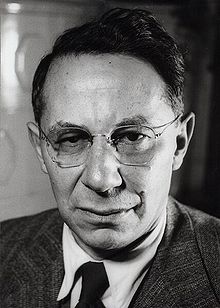Tadeus Reichstein
Tadeus Reichstein (born July 20, 1897 in Włocławek , Congress Poland , as Tadeusz Reichstein , later also Thadeus ; † August 1, 1996 in Basel , Switzerland ) was a Swiss chemist and botanist . He received the Nobel Prize in Physiology or Medicine in 1950 .
School, studies and activities
Tadeusz Reichstein spent his early childhood in Kiev , went first in Jena to school and came after his family had emigrated to Switzerland in 1906, eight years into Switzerland , where he spent the 1914 Swiss citizenship received. After attending the industrial school in Zurich (Oberrealschule, today MNG Rämibühl ), he studied chemistry at the ETH Zurich and received his doctorate in 1921 under Hermann Staudinger with a thesis on open-chain tropine and some of its homologues . In 1929 his habilitation took place on the composition of the aromatic substances of roasted chicory and work in the heterocyclic series in the field of organic chemistry.
In 1931 he became an assistant to Leopold Ružička , and in 1937 he was appointed associate professor of special organic and physiological chemistry at the ETH Zurich . From 1938 he took over the management of the Pharmaceutical Institute of the University of Basel and in 1946 the chair of organic chemistry . From 1960 to 1967 he was director of the Institute for Organic Chemistry at the University of Basel.
Discoveries, developments and the Nobel Prize
For his discoveries about the hormones of the adrenal cortex, their structure and their biological effects , he received the Nobel Prize in Medicine in 1950 together with Edward Calvin Kendall and Philip S. Hench . He was a member of the Swiss Academy of Medical Sciences .
Reichstein isolated hormones from the adrenal cortex , clarified, among other things, the molecular structure of the vital aldosterone and recognized the therapeutic effectiveness of cortisone in the treatment of rheumatic diseases. He was one of those people who isolated cortisone in the second half of the 1930s and was the first to produce cortisol or hydrocortisone in 1937/38. In 1932, Tadeusz Reichstein produced ascorbic acid (vitamin C) using the Reichstein synthesis he developed , which was suitable for industrial production. Using his method, the pharmaceutical company Hoffmann-La Roche produced over 50 kilograms of vitamin C as early as 1934. In 1935, Reichstein developed the active ingredient deoxycorticosterone acetate (DOCA), which was successful even in very severe cases of Addinson’s disease . It was marketed by Ciba as a percorten.
In 1952 he was elected to the National Academy of Sciences and in 1957 to the American Academy of Arts and Sciences .
After his retirement in 1967 he devoted himself to the study of ferns and described, among other things, the fern Asplenium creticum . His botanical author abbreviation is Reichst. , he also worked on the striped fern family (Aspleniaceae) in the work Illustrierte Flora von Mitteleuropa, edited by Karl Ulrich Kramer .
Reichstein was the first Nobel Prize winner to reach the age of 99.
Fonts (selection)
- A potent crystalline substance found in the cortex of the adrenal gland, corticosterone. Amsterdam 1936
- Chemistry of the adrenal cortex hormones , Nobel Lecture, given at the Carolinian Hospital, Stockholm on December 11, 1950, Nordstedt 1951
- with Oswald Renkonen and Othmar Schindler: The constitution of sinogenin: glycosides and aglycones. Zagreb 1957
- The sugars of the cardiac glycosides. In: Fourth International Congress of Biochemistry, I: Carbohydrate Chemistry of Substances of Biological Interest. , London 1958, pp. 124-139.
- with Bernhard Lang and M. Maturova: Isolation of the substances from "Gloriosa superba Levin". Stuttgart 1959
- Characteristics of the sugars of cardiac glycosides. Weinheim 1962
- with Adolf Portmann as editor: Hormones - substances that control life. Basel 1967
literature
- Christoph Tamm: Reichstein, Tadeus. In: New German Biography (NDB). Volume 21, Duncker & Humblot, Berlin 2003, ISBN 3-428-11202-4 , p. 321 f. ( Digitized version ).
- Marcel H. Bickel: Tadeus Reichstein. In: Historical Lexicon of Switzerland .
Web links
- Literature by and about Tadeus Reichstein in the catalog of the German National Library
- Works by and about Tadeus Reichstein in the catalog of the Swiss National Library
- Information from the Nobel Foundation on the 1950 award ceremony for Tadeus Reichstein (English) and a banquet speech (German)
- Tadeus Reichstein , brief portrait of the ETH library
- Author entry and list of the described plant names for Tadeus Reichstein at the IPNI
Individual evidence
- ^ Uwe Boehm: Reichstein, Taddeus. In: Werner E. Gerabek , Bernhard D. Haage, Gundolf Keil , Wolfgang Wegner (eds.): Enzyklopädie Medizingeschichte. De Gruyter, Berlin / New York 2005, ISBN 3-11-015714-4 , p. 1229.
- ^ Dietrich von Engelhardt: Biographical encyclopedia of German-speaking natural scientists. Volume 2, Munich 2003, p. 722
- ^ Reichstein, Tadeus ( Memento of December 29, 2011 in the Internet Archive ) at cartage.org.lb
- ^ Tadeus Reichstein: Aspleniaceae . In: Karl Ulrich Kramer (ed.): Illustrated flora of Central Europe. Pteridophyta, Spermatophyta . Founded by Gustav Hegi. 3rd, completely revised edition. Volume I. Part 1 Pteridophyta . Paul Parey, Berlin / Hamburg 1984, ISBN 3-489-50020-2 , p. 252-254 .
| personal data | |
|---|---|
| SURNAME | Reichstein, Tadeus |
| ALTERNATIVE NAMES | Reichstein, Tadeusz (maiden name); Reichstein, Thadeus |
| BRIEF DESCRIPTION | Swiss chemist and botanist |
| DATE OF BIRTH | July 20, 1897 |
| PLACE OF BIRTH | Włocławek |
| DATE OF DEATH | August 1, 1996 |
| Place of death | Basel |

